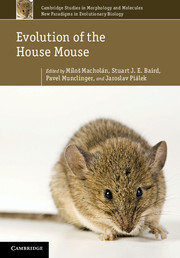Crossref Citations
This Book has been
cited by the following publications. This list is generated based on data provided by Crossref.
Kawakami, Takeshi
and
Butlin, Roger K
2012.
Encyclopedia of Life Sciences.
Macholán, M.
2013.
Brenner's Encyclopedia of Genetics.
p.
588.
Karn, Robert
Chung, Amanda
and
Laukaitis, Christina
2013.
Shared and Unique Proteins in Human, Mouse and Rat Saliva Proteomes: Footprints of Functional Adaptation.
Proteomes,
Vol. 1,
Issue. 3,
p.
275.
Giménez, Mabel D.
White, Thomas A.
Hauffe, Heidi C.
Panithanarak, Thadsin
and
Searle, Jeremy B.
2013.
UNDERSTANDING THE BASIS OF DIMINISHED GENE FLOW BETWEEN HYBRIDIZING CHROMOSOME RACES OF THE HOUSE MOUSE.
Evolution,
p.
n/a.
Hiadlovská, Zuzana
Macholán, Miloš
Mikula, Ondřej
and
Vošlajerová Bímová, Barbora
2014.
The meek inherit the earth: less aggressive wild mice are more successful in challenging situations.
Biological Journal of the Linnean Society,
Vol. 113,
Issue. 1,
p.
310.
Bryja, Josef
Mikula, Ondřej
Šumbera, Radim
Meheretu, Yonas
Aghová, Tatiana
Lavrenchenko, Leonid A
Mazoch, Vladimír
Oguge, Nicholas
Mbau, Judith S
Welegerima, Kiros
Amundala, Nicaise
Colyn, Marc
Leirs, Herwig
and
Verheyen, Erik
2014.
Pan-African phylogeny of Mus (subgenus Nannomys) reveals one of the most successful mammal radiations in Africa.
BMC Evolutionary Biology,
Vol. 14,
Issue. 1,
Lister, Adrian M.
and
Hall, Charlotte
2014.
Variation in Body and Tooth Size with Island Area in Small Mammals: A Study of Scottish and Faroese House Mice (Mus musculus).
Annales Zoologici Fennici,
Vol. 51,
Issue. 1-2,
p.
95.
Fornuskova, Alena
Bryja, Josef
Vinkler, Michal
Macholán, Miloš
and
Piálek, Jaroslav
2014.
Contrasting patterns of polymorphism and selection in bacterial‐sensing toll‐like receptor 4 in two house mouse subspecies.
Ecology and Evolution,
Vol. 4,
Issue. 14,
p.
2931.
Kreisinger, Jakub
Čížková, Dagmar
Vohánka, Jaroslav
and
Piálek, Jaroslav
2014.
Gastrointestinal microbiota of wild and inbred individuals of two house mouse subspecies assessed using high‐throughput parallel pyrosequencing.
Molecular Ecology,
Vol. 23,
Issue. 20,
p.
5048.
Krojerová-Prokešová, Jarmila
Barančeková, Miroslava
and
Koubek, Petr
2015.
Admixture of Eastern and Western European Red Deer Lineages as a Result of Postglacial Recolonization of the Czech Republic (Central Europe).
Journal of Heredity,
Vol. 106,
Issue. 4,
p.
375.
Kropáčková, L.
Piálek, J.
Gergelits, V.
Forejt, J.
and
Reifová, R.
2015.
Maternal–foetal genomic conflict and speciation: no evidence for hybrid placental dysplasia in crosses between two house mouse subspecies.
Journal of Evolutionary Biology,
Vol. 28,
Issue. 3,
p.
688.
Phifer-Rixey, Megan
and
Nachman, Michael W
2015.
Insights into mammalian biology from the wild house mouse Mus musculus.
eLife,
Vol. 4,
Issue. ,
Karn, Robert
and
Laukaitis, Christina
2015.
Comparative Proteomics of Mouse Tears and Saliva: Evidence from Large Protein Families for Functional Adaptation.
Proteomes,
Vol. 3,
Issue. 3,
p.
283.
Dion-Côté, Anne-Marie
Symonová, Radka
Ráb, Petr
and
Bernatchez, Louis
2015.
Reproductive isolation in a nascent species pair is associated with aneuploidy in hybrid offspring.
Proceedings of the Royal Society B: Biological Sciences,
Vol. 282,
Issue. 1802,
p.
20142862.
Hautier, Lionel
and
Cox, Philip G.
2015.
Evolution of the Rodents.
p.
1.
Tourmente, M.
Zarka‐Trigo, D.
and
Roldan, E. R. S.
2016.
Is the hook of muroid rodent's sperm related to sperm train formation?.
Journal of Evolutionary Biology,
Vol. 29,
Issue. 6,
p.
1168.
Harr, Bettina
Karakoc, Emre
Neme, Rafik
Teschke, Meike
Pfeifle, Christine
Pezer, Željka
Babiker, Hiba
Linnenbrink, Miriam
Montero, Inka
Scavetta, Rick
Abai, Mohammad Reza
Molins, Marta Puente
Schlegel, Mathias
Ulrich, Rainer G.
Altmüller, Janine
Franitza, Marek
Büntge, Anna
Künzel, Sven
and
Tautz, Diethard
2016.
Genomic resources for wild populations of the house mouse, Mus musculus and its close relative Mus spretus.
Scientific Data,
Vol. 3,
Issue. 1,
Giménez, Mabel D.
Förster, Daniel W.
Jones, Eleanor P.
Jóhannesdóttir, Fríða
Gabriel, Sofia I.
Panithanarak, Thadsin
Scascitelli, Moira
Merico, Valeria
Garagna, Silvia
Searle, Jeremy B.
and
Hauffe, Heidi C.
2017.
A Half-Century of Studies on a Chromosomal Hybrid Zone of the House Mouse.
Journal of Heredity,
Vol. 108,
Issue. 1,
p.
25.
Bryja, Josef
Meheretu, Yonas
Šumbera, Radim
and
Lavrenchenko, Leonid A.
2019.
Annotated checklist, taxonomy and distribution of rodents in Ethiopia.
Folia Zoologica,
Vol. 68,
Issue. 3,
p.
117.
Zima, Jan
and
Searle, Jeremy B.
2019.
Shrews, Chromosomes and Speciation.
p.
1.





